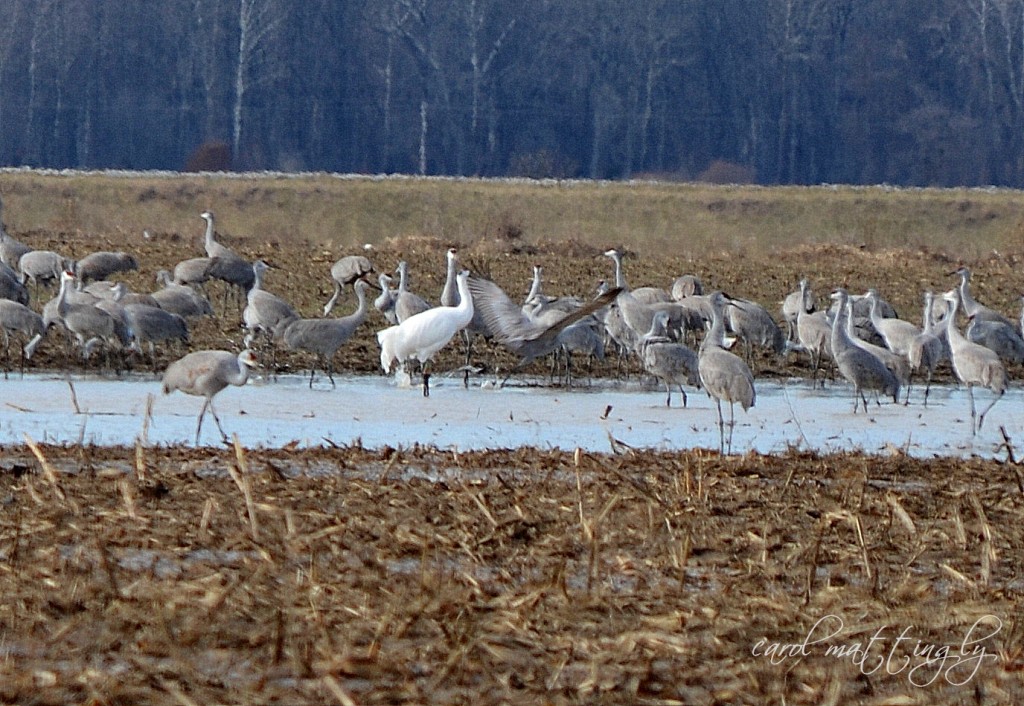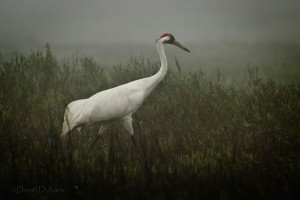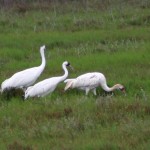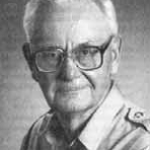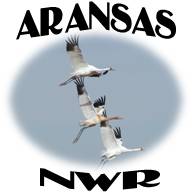Archive for January 22, 2013
Photographing a Whooping Crane
January 22, 2013Editor’s note: Our members and viewers of our web site often write us about their observations of whooping cranes. Some even send us photos. We always appreciate these. We enjoy sharing some of these submissions with you. We just received some photographs from Carol Mattingly. She also wrote about her experience. Her article is posted below. If you have interesting experiences and photos and would like to have us place them on the web site, please go to our web site whoopingcrane.com . Then click on “Report A Sighting” and fill out the form and click “Send”.
Photographing a Whooping Crane
By Carol Mattingly, Carol Mattingly Photography
Turning left onto a two lane dirt farm road, I edged my car just past an unplowed field and there standing in several inches of water picking at the ground in hopes of finding food was a beautiful adult Whooping Crane. How he could possibly find anything to eat in this field made me wonder. This region had just experienced the most severe drought in recorded history just this past summer. The seeds planted in these fields could not possibly have yielded any crops. Possibly weed seeds and insects were there.
It was a sunny Sunday afternoon and I had made my way to south Indiana just on the other side of a river bridge. The Bottoms is generally what the locals call this area. And after heavy rains the week before, I could see why it is called bottomland. There were large pools of standing water in all of the fields.
And for as far as the eye could see, on this particular Sunday, there were hundreds and hundreds and hundreds of Sandhill Cranes. And standing amongst the Sandhills was this one solitary Whooping Crane. I wondered if it had mated with one of the Sandhill Cranes and would it be traveling with this huge flock of Sandhill Cranes for years to come.
Seeing my first Whooping Crane was a fantastic treat, but getting a fairly decent image of the crane was ever better. I did not want to get too close for fear of frightening the birds. The Whooping Crane stood for some time looking around and I knew that was my opportunity to snap a few images. I love the way the Sandhill Cranes feathers lay across the back of their rump in a poof. But this Whooping Crane’s white feathers lying across his rump was so beautiful. I wonder if he knew he was the star of the show that Sunday. See my photo below:
The Man Who Saved the Whooping Crane
January 13, 2013Preface: After having read Kathleen Kaska’s book, “The Man Who Save the Whooping Crane: The Robert Porter Allen Story”, I needed to know more about this man who, if it hadn’t been for his dedication and perseverance, there probably wouldn’t be whooping cranes today.
While searching for every morsel of information pertaining to the whooping cranes before and during Allen’s time, I often thought of what a wonderful adventure and treasure hunt Kathleen must have had doing her research for the book. I contacted Kathleen to ask if she would like to write a short article outlining her feelings and experiences while researching “The Man Who Saved the Whooping Crane”. Immediately, she responded with “yes” and that she would love to. Below is an account of her adventures, which she has graciously written for us.
Thank you, Kathleen for sharing the life of Robert Porter Allen and your adventures of researching and writing the book.
Pam Bates, Whooping Crane Conservation Association ———————————————-
The Man Who Saved the Whooping Crane: The Robert Porter Allen Story
by Kathleen Kaska
By the time I began writing about the life and adventures of Robert Porter Allen, several decades had passed since he traipsed through the Canadian wilderness in search of the whooping crane’s last nesting site.
I first became aware of Allen’s work while designing an environmental/ecology unit for my
seventh-grade science class. The school librarian provided me with a National Geographic video about the efforts that had been made to save the whooping crane from extinction. The video briefly touched on Allen’s contributions, but it was enough to peak my interest. A few weeks later, I headed for the Texas coast to see the cranes on their wintering grounds at the Aransas National Wildlife Refuge. I’ll never forget that cold morning when I stood on the deck of the Wharf Cat tour boat gazing at those majestic birds through my binoculars—they simply took my breath away and at that moment I, too, wanted to make a difference in the whooping crane’s survival.At the time, I was also writing for Texas Highways magazine. When I returned home, I fired off a query to the editor, offering to write a story about Allen and the plight of the cranes. While researching the article, I realized that Allen had all but been forgotten. I felt his contribution to the world of ornithology and his story about his efforts to save the whooping cranes were too important to be lost. I decided to turn my research into a book.
Allen died in 1963. Considering all the time that had passed, finding someone who knew him well enough to paint a vivid picture of the Audubon ornithologist seemed an impossible task. I called the Florida Audubon chapter, located at the Tavernier Science Center, and learned that his daughter, Alice Allen, was living in Tavernier. I called her and introduced myself and told her about my plans. A few weeks later, I was on a plane to Florida.
Alice was only a young girl at the time her father had been named the director of the Whooping Crane Project in 1946. She was most generous in sharing her recollections of her father’s work, but I needed a wider perspective. I then visited the Science Center where most of Allen’s correspondences, published articles, photographs, and hand drawn maps are kept. Thanks to resident biologist, Pete Frezza, I even had the opportunity to motor out into Florida Bay to Bottlepoint Key where Allen had conducted his spoonbill research in 1939.
I had enough information to write the book proposal, which I eventually sent to University Press of Florida. By the time I received word of the book’s acceptance, my husband and I were on a two-year across-country retirement trip. Coming along with us on the trip, and taking up too much space in the truck of our car, were my research notes, tapes, and books. Over the next several months, I wrote the book in while on the road.
After it’s publication, I began giving presentations, which I entitled “On the Trail of a Vanishing Ornithologist,” named after Allen’s award-winning book, On the Trail of Vanishing Birds. That road trip provided me with the opportunity to visit sites I was writing about: Allen’s hometown in South Williamsport, Pennsylvania, Cornell University where Allen was enrolled in the early 1920s, Hopper’s Landing in Texas where Allen lived while working on the Aransas National Wildlife Refuge, and what proved to be invaluable, a second trip to see Alice and visit the Tavernier Science Center. Alice had uncovered more photos and information. Dr. Jerry Lorenz, the director of the Audubon Center and Flamingo Research Project and Allen successor twice removed, provided me with Allen’s research journals. These journals not only contained detailed accounts of his research, but also personal information; his feelings about being away from home and missing his family; his frustration with delays in moving forward with the Whooping Crane Project; his views on captive breeding program; anecdotes of his travels, which gave me a greater insight to his charismatic personality and sense of humor.
Most of the locations we visited were on our agenda. However, one particular serendipitous event led to an unbelievable experience. While traveling through Florida just south of Tallahassee, we noticed Wakulla Springs State Park, a hot spot for birding, was only a few miles away. We made a slight detour and upon arrival, checked into the historic Wakulla Spring Lodge for a two-night stay.
That afternoon on the birding boat tour, I met Betty and Lou Kellenberger, wildlife photographers and whooping crane devotees. They told me about the Whooping Crane Festival coming up that weekend at St. Mark’s National Wildlife Refuge. Representatives from Operation Migration (OM) and the International Crane Foundation (ICF) were speaking. That’s all I needed to hear. We added two more nights to our stay so I could attend. Although I missed seeing OM ultralight pilot, Brooke Pennypacker, I met Joan Garland with ICF. I told her about my book and she invited me to tour the ICF in Baraboo, Wisconsin later that year.
Looking at our map and calendar, I realized the Necedah National Wildlife Refuge, the location where OM trains whooping crane chicks to migrate, was nearby and that we’d be driving through the area during the time the Class of 2012 chicks would be training. About a week before we arrived in Wisconsin, I emailed Joan and asked if we could watch one of the training exercises. She made a few phone calls, and on the morning of August 12, my husband and I stood in a bird blind with pilot Richard van Heuvelen and lead technician Barb Clauss, both dressed in crane costumes, as they explained the morning’s training plan. Richard left to revive up the ultralight while Barb prepared to released the chicks. Watching those gangly young whoopers rush out of their pen and take to the air was one of the best moments of my life. I had to choke back tears. My husband, who’d spent years listening to me talk about OM, turned to me and said, “Now, I get it.” There were tears in his eyes, too.”
Visiting these sites, discovering Allen’s journal, and watching those chicks fly was just what I needed to give The Man Who Saved the Whooping Crane: The Robert Porter Allen Story, that special emotional element to transform the book from a mere biography into a true-life adventure story.
The book was released on September 16, 2012. Shortly afterwards, I received word that it had been nominated for the George Perkins Marsh Award for Environmental History.
Here’s an excerpt of the book:
It was April 17, 1948 in the early hours of a muggy Texas morning on the Gulf Coast. The sun at last burned away the thick fog that had settled over Blackjack Peninsula. The world’s last flock of wild whooping cranes had spent the winter feeding on blue crab and killifish in the vast salt flats they called home. During the night, all three members of the Slough Family had moved to feed on higher ground about two miles away from their usual haunt. The cool, crisp winter was giving way to a warm balmy spring, the days were growing longer, and territorial boundaries were no longer defended. Restlessness had spread throughout the flock.
As Robert Porter Allen drove along East Shore Road near Carlos Field in his government issued beat-to-hell pickup, he spotted the four cranes now spiraling a thousand feet above the marsh. He pulled his truck over to the roadside and watched, hoping to witness, for the first time, a migration takeoff. One adult crane pulled away from the family and flew northward, whooping as it rose on an air current. When the others lagged behind, the crane returned, the family regrouped, circled a few times and landed in the cordgrass in the shallows of San Antonio Bay. It was Allen’s second year at the Aransas National Wildlife Refuge. He had learned to read the nuances of his subjects almost as well as they read the changing of the seasons.
In the days preceding, twenty-four cranes left for their summer home somewhere in Western Canada, possibly as far north as the Arctic Circle. This annual event, which had been occurring for at least 10,000 years, might be one of the last unless Allen could accomplish what no one else had. The next morning when Allen parked his truck near Mullet Bay, the Slough Family was gone, having departed sometime during the night. That afternoon, he threw his gear into the back of his station wagon and followed.
THE MAN WHO SAVED THE WHOOPING CRANE: THE ROBERT PORTER ALLEN STORY—September 2012: University Press of Florida
Total Whooper Population Count Urged
January 6, 2013by Chester McConnell, WCCA
Whooping Crane Conservation Association (WCCA) president Lorne Scott has urged Secretary Ken Salazar, U.S. Department of the Interior to resume regular aerial total population counts of whooping cranes on Aransas Refuge. The aerial census of the total whooping crane population has been used for the past 61 years. During 2012, the U.S. Fish and Wildlife Service decided to convert to a statistical survey method using hierarchical distance sampling. In a letter to Secretary Salazar, President Scott writes, “The WCCA sees the total count census as the most practical, economical and having the most scientific value”. Citing the Service’s “2011-2012 estimate of 254 plus or minus 62 Whooping Cranes”, Scott wrote, “This degree of uncertainty for a critically endangered species is simply unacceptable. President Scott’s letter is posted below:
January 4, 2013
Ken Salazar,
Secretary U.S. Department of the Interior
1849 C Street NW
Washington, DC 20240Dear Mr. Salazar:The annual winter census of endangered Whooping Cranes has been an event looked forward to by the conservation community since Aransas National Wildlife Refuge was established in 1937. The aerial total population count, done for the past 61 years, was changed by USFWS in the winter of 2011-2012 to a survey method using hierarchical distance sampling. As stated by USFWS, the new sampling method is only 85% accurate.The Whooping Crane Conservation Association (WCCA) believes the total population count is much preferred to the current estimate that has little value. Estimates are not satisfactory when dealing with this bird which is considered a flagship among all endangered species. Only about 300 birds exist in this wild population and it is still possible to do a total population count. Potentially, a dozen or even thirty five birds could die or disappear and the sampling technique would not detect the change. The new counting system only indicates that some low number of cranes are still present. It does not tell us whether this endangered population has increased or decreased from the previous year. The refuge’s 2011-2012 estimate of 254 plus or minus 62 Whooping Cranes does not serve any management purposes, nor does it provide worthwhile public information. This degree of uncertainty for a critically endangered species is simply unacceptable.
The Whooping Crane is an internationally endangered species, and as such the concerns of the international community should be considered. Because of this high level of interest, and the endangered status of the species, accurate total population counts should be continued annually.
The WCCA sees the total count census as the most practical, economical and having the most scientific value. Three aerial counts between December 1 and 20 would provide a good count of the total number of birds arriving in the winter population. Flights every two weeks, after the December 20 count, until the cranes return north, would provide estimates of population losses during the winter. We note that as of December 27, 2012, the Aransas Refuge new website still does not report any crane numbers from approximately seven flights conducted this fall. We urge you to resume regular aerial total population counts as soon as possible. The WCCA looks forward to continuing its support of the international Whooping Crane conservation efforts, as we have done for the past fifty years.
Sincerely,
Lorne Scott,
President
Whooping Crane Conservation Associationcc: Dan Ashe, Dr. Benjamin Tuggle, Hon. Peter Kent, Wendy Brown, Dr. Grant Harris, Aaron Archibecque, Sonny Perez, Dr. Wade Harrell, LeeAnn Linam, Dr. Rich Beilfuss, Dr. George Archibald, Joseph Duff, Dr. Mark Bidwell, Dr. Sandy Black, Ron Outen, Marty Folk, Alan Strand, Dr. Felipe Chavez-Ramirez, Dr. John French,Larry Schweiger, Wade Luzny
WCCA has previously expressed its concerns about the lack of reports on whooping crane nesting success on Canada’s Wood Buffalo National Park as well the winter aerial census on U.S. managed Aransas National Wildlife Refuge ( https://whoopingcrane.com/whooping-crane-program-concerns/ ) . The public in both the U.S and Canada is very interested in, and highly supportive of, the endangered whooping crane programs. WCCA has received a number of inquiries about the changes to the census program. Hopefully Secretary Salazar will get the program back on track.
Whooper Nesting Grounds Located (History)
January 2, 2013****History Briefs compiled by Whooping Crane Conservation Association****
Editor Note: For many years no one knew exactly where whooping cranes nested. Until 1954 whooping crane interests only knew that the birds migrated from “somewhere” in Canada to the Texas Coast. Crane interests had watched as the whooper population declined to 16 individuals in 1941. Pressures were brought on government agencies to protect and manage the birds. It was important to locate the whooper nesting habitats so these essential areas could be protected. In 1954 the whooping crane nesting area was finally located. The story is an interesting part of history. Whooping Crane Conservation Association member Pam Bates researched the literature and came across an article published in “Wild Lands Advocate” that tells the story. This is a follow-up to another article on our web page published on December 23, 2012. Click on the following link for the related story: https://whoopingcrane.com/whooping-cranes-from-despair-to-hope-to-progress/
DISCOVERY OF THE NESTING GROUND OF THE WHOOPING CRANE *
by Dr. W. A. Fuller
I have received a lot of credit for the discovery in 1954 of the only whooping cranes in Canada, but if it hadn’t been for the fire and an observant forester named George Wilson, I might never have gone out to identify the birds. The last nest of a whooping
crane had been seen in about 1926 in Saskatchewan. Members of the U.S. Fish and Wildlife Service (USWS) and others had searched from central Saskatchewan to the delta of the Mackenzie River without success. The USWS was interested because whoopers migrated to Texas.In 1945 I spent the summer working on fish in Lake Athabasca. At the end of the summer I decided that I would never return to the north. However, in 1946 I signed up to spend the summer at Great Slave Lake. The following winter I put together all the data that had been gathered over several years on the “Inconnu” (Stenodus leucichthys) and submitted the result as my masters thesis for the University of Saskatchewan. Convocation took place in early May.
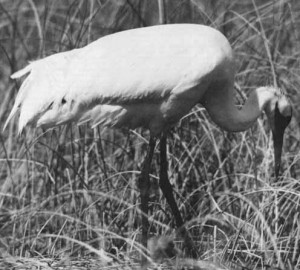
Whooping crane. (From a 1982 Hinterland Who’s Who brochure on the Whooping Crane written by E. Kuyt and published by the Canadian Wildlife Service)
A few days after the ceremony, I turned 23, and on the last day of May I married the young lady who is still my wife. I had previously applied for one of two jobs advertised by the federal government, and I was approved for the one based in Fort Smith, NWT. I found the north gets under your skin, and my wife Marie and I landed in Fort Smith on June 5. My duties centred on mammals in the south half of the Mackenzie District and in Wood Buffalo National Park (WBNP), part of which is in Alberta.In those days, the United States sent a bird guy, Bob Smith, and an assistant down to the Arctic Ocean. They flew out of Fort Smith for two or three days, and I usually took them up on their invitations to go on their sorties. Bob was a great guy, as well as a good pilot and a good bird man. Although waterfowl were the main target, they kept their eyes open for other birds, such as whooping cranes. As late as 1954 they had not made a sure discovery of whoopers, although on an earlier flight with them, one thought he had spotted a crane, but by the time Bob swung the plane around, whatever had been seen had disappeared.
In June 1954, a fire broke out in the northern part of Wood Buffalo Park. On June 30, the fire crew radioed to Fort Smith that one of their pumps was out of order. The forestry guy, George Wilson, went out to the site of the fire in a whirlybird piloted by Don Landells. I was in my office around 4:00 p.m. when a message came in from the plane to the effect that George and Don had seen a few big white birds, which they suspected were whooping cranes. Furthermore, Landells was to make another trip on the same route with a new pump, and if Bill Fuller was at the landing spot at 5:00 p.m he. could go back with Don and the pump.
Bill Fuller was at the landing and ready to go at 5:00 p.m. Don took us back on about the same route he had flown earlier, and we did see some large white birds, which were certainly whoopers. There were young birds as well as adults, so there was reason to believe that the nesting grounds were not too far away. I think we saw about nine birds on that first trip. I sent a telegram to the head office in Ottawa later that evening.
Ottawa’s reply the next morning asked me to keep an eye on the birds whenever there was a chance. I made several trips on an ordinary prop plane. On one such trip I counted thirteen birds, which was just over half of the birds (21, I think) counted in the Texas flock at that time.
The Whooping Crane Society and the USWS were very excited about the discovery, and soon there was talk about a ground survey in 1955. Canadian and American scientists would carry it out. However, the Canadian Wildlife Service (CWS) did not want to commit to that until there was proof of nesting, so I was to take a look next spring as early and as often as possible.
In those days, light aircraft landed on skis in winter and on pontoons in summer. The changeover was made in Edmonton in spring and fall, so it was difficult to find tansportation just when I needed it. While our government plane was in Edmonton, I got a ride with a pilot from Yellowknife on his way to Edmonton.I got another ride in a plane owned by the RCMP in Fort Smith. On that flight I saw what could only be a crane sitting on a nest. So the ground survey was on. Robert P. Allen of the National Audubon Society was to lead it. When Allen arrived in Fort Smith, we made one flight over the area so I could show him the location of the known nests.
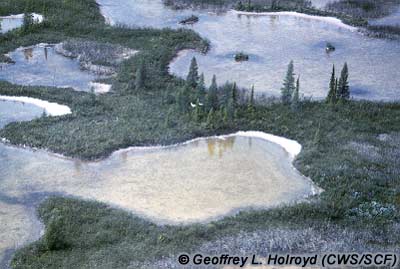
The nesting habitat of the Whooping Crane consists of marshes, shallow ponds, small creeks, and patches of wooded terrain and shrubs. Note two whooping cranes in the center of the photograph.
I made other flights, and I think I found a few more nest sites, but when the ground survey came on, I was at a conference in Alaska. The attempted ground survey is a story of its own.In 1956 I moved to Whitehorse in the Yukon, and Ernie Kuyt of the CWS took over work on the cranes. I had flown over the region of the first sightings a number of times. I had noted the tracks in the mud and searched my brains for a mammal that would make such a trail in the soft mud of the lake bottoms. Big birds never crossed my mind until I saw the cranes there in 1955.So who discovered the nesting ground? Wilson and Landells, who saw the big white birds? Me, because I saw young birds as well as mature birds on my sorties in 1955 and was also the first to see a female on a nest in the spring of 1956?It doesn’t really matter. The important point is that an important nesting ground was found. Each year for several more years, Ernie Kuyt found new nests. The total number of cranes in the Texas/WBNP flock has continued to increase in most, if not all, years since 1955.b
* Published in Wild Lands Advocate, The Alberta Wilderness Association, December 2004 • Vol.12, No. 6, pages 16 and 17.
